Solarenergie für Afrika
Konferenz in Düsseldorf vom 4.-6. September 2003
Applications of Renewable Energy in Libya
Mr. El Hori
1. Introduction
Libya is an oil exporting country located in the middle of North Africa, with around 6 million inhabitants, has a total area over 1,750,000 Km2 the daily average of solar radiation on a horizontal plane is 7.1 kwh/m2/day in the coastal region and 8.1 kwh/m2/day in the southern region. The sun duration ranges from 3000 to 4000 hour per year .The average wind speed in many areas ranges from 5 to 8 m/sec especially in coastal region.
Moreover, renewable energy provides clean and reliable energy sources which can be used in many applications in remote areas (electricity supply, water pumping,…etc.), All these facts encourage the use of renewable energy wherever it is applicable and needed.
The national electrical grid consists of a high voltage 220KV network of about 12,000 km, a medium voltage 66 & 30 KV network of about 20000 km. The installed Thermal power Generation capacity is about 4600 MW, and The peak Demand is 3100 MW recorded during the Year 2002.
This paper gives an overview of the Renewable Energy application in Libya and the experience gained out of the applications used in the field of renewable energy.
2. Renewable Energy applications
The use of renewable energies have been introduced in a wide applications due to its convenience use and being economy effective in many application , the renewable energy used in Libya consists of photovoltaic , solar thermal application ,and wind energy.
2.1 Photovoltaic
In 1976 many major PV projects in Libya has been put into work in many applications which are different in size and type . The first project put into work is a PV system to supply a cathodic protection to protect the oil pipe line connecting Dahra oil field with Sedra Port. Projects in the field of communication was started 1980 where a PV system was used to supply energy to the microwave repeater station near Zella. Projects in the field of water pumping was started 1983 where a PV pumping system was used to pump water for irrigation at El-Agailat. The use of PV systems for lighting was started as street lighting and then used in Historical sights lighting . The role of PV application was grown in size and type of application.
2.1.1 Photovoltaic applications
- PV Systems in communication
The use of photovoltaic systems as a power generator in communication was established not only in the industrial countries but also in the developed ones, where PV systems were used in communications field as a power supply in Microwave networks, VSAT stations, and railway communications.
The Microwave networks for communications in Libya extends over 8000 Km through out the country. In the past repeater stations, which are away from cities, or away from general electric grid are supplied by electric power supplied by diesel generators as the main power supply. Twenty two systems of which has been put into work in the beginning of 1998, and since then these stations deliver the required energy with high reliability and very low running cost;. The total installed capacity of PV systems in this field is 319 Kwp which is shown below.
- Cathodic protection
The first system in this field was put into work in 1976 , the use of PV systems in this field is second to PV systems in communications , the total PV systems in this field is 227 system with a total capacity of 295 Kwp.
- Total installed capacity in the field of PV systems
The following table and figure show the PV installed in Libya by 5/2003
| Total installed power [KWp] |
Number of systems |
applications |
| 318.39 |
114 |
communications |
| 294.679 |
227 |
Cathodic protection |
| 17.908 |
7 |
Water pumping |
| 2.900 |
14 |
lighting |
| 633,880 |
362 |
total |
2.1.2 PV Systems in progress
Due to the readability of PV systems the use of PV systems has been widen both in size and in type of applications , the following table shows the PV systems being installed now.
| Authority |
Type of applications |
No. of systems |
Total peak power [KWp] |
| GECOL |
Rural Electrification |
370 |
310 |
| Solar center |
Rural Electrification |
150 |
116 |
| Saharian center |
Rural Electrification |
6 |
9 |
| Waha Oil Company |
Cathodic protection |
5 |
30 |
| Total |
|
531 |
465 |
2.1.3 Total PV Capacity by the end of 2003
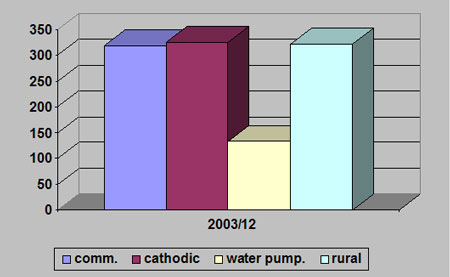
total installed capacity by the end of 2003
2.1.3 Expected PV systems to be installed in the very near future
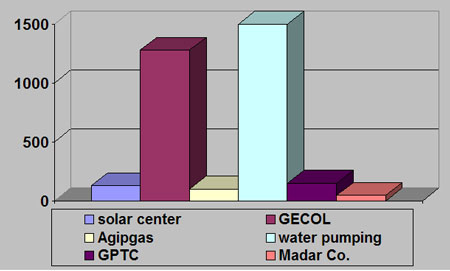
PV systems and their capacity which will be installed in the very near future
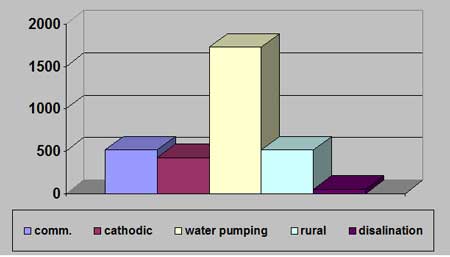
total PV power which will be installed
3 Planned and under execution Renewable Energy Projects
3.1 Under execution projects
3.1.1 Wind and Solar Atlases Project:
The ultimate goal of this project is to present two Atlases that provide fact access to reliable solar and wind data through out Libya. The Atlases allow for accurate analysis of the available wind and solar resources anywhere in Libya, and is therefore very valuable for planning profitable wind farms and solar projects.
In this project a 42 stations will be installed, 6 of them are main stations and 36 are secondary stations located in different regions in Libya.
3.1.2 Desalination pilot project powered from renewable energy sources:
The General Electricity Company of Libya (GECOL) is planning to install of a pilot plant for Sea Water Reverse Osmosis desalination powered from Renewable Energy Sources . The nominal production of the plant will be 300 m³/d for the supply of a village with potable water. Both wind energy conversion and photovoltaic (PV) power generation will be integrated into a grid connected power supply for a Reverse Osmosis (RO) desalination plant with power recovery.
The project has been designed to achieve the following goals :
- Conduct economical analysis for such proposed configurations.
- Acquire know-how transfer in the field of combining different power supply sources to operate small-scale desalination unit.
- Acquire enough metrological data for the selected site.
3.1.3 Rural electrification using photovoltaic systems :
The connection of remote villages to the national grid has not been considered as the most of these village are scattered far away from the grid without any visible concentrated population .Many villages that are supplied by electricity generated from diesel engines suffers from the well known causes of frequent interruption due to either lack of fuel supply as most of these villages are not only isolated from being near big cities but also isolated from road services . These factors encourages GECOL to use photovoltaic systems to supply electrical energy to these areas .
The installation of photovoltaic systems started in the middle of 2003 . The total number of systems to be installed is 370 with total capacity of 310 kw for all applications as follow:
- 220 systems for isolated house.
- 30 systems for water pumping systems.
- 20 systems for police station.
- 100 systems for street light.
3.1.4 Establishing a wind farm pilot project:
GECOL has initiated project investigating possible wind energy application in Libya .Main objectives are the determination of the wind resources to establish a wind farm connected to the grid. A consultation firm is performing a complete feasibility study for a suitable wind farm site including among others, technical design, economic analysis as well as setting the specification of the equipment of the wind farms.
Five meteorological stations are already installed as apart of this study located in different areas of the coastal region. From the analysis of wind data collected from the stations shown in the below figure that there is a very good potential of wind which can be used to install a wind farm(s) connected to the grid
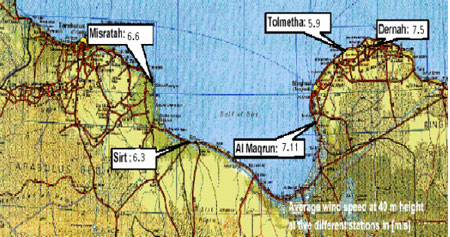
the average wind speed for the five wind stations
3.1.5 One MW PV pilot plant in Libya
GECOL is now planning a PHOTOVOLTAIC project of 1 MW capacity grid connected system. The site of the plant is already decided.
This pilot PHOTOVOLTAIC project is intended to accommodate know - how on PHOTOVOLTAIC technology and on the operation , maintenance and management of a large PHOTOVOLTAIC system , in preparation for larger - scale installations in the future. The consulting firm is already selected employed to prepare detailed design of the pilot plant, to produce a tender specifications for selecting the supplier and to supervise the project implementation.
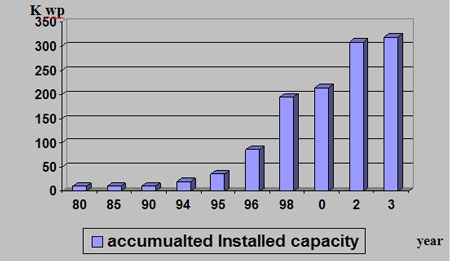
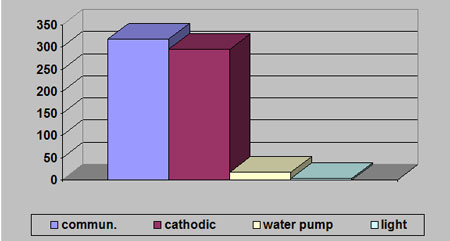
 total installed capacity by the end of 2003
total installed capacity by the end of 2003 PV systems and their capacity which will be installed in the very near future
PV systems and their capacity which will be installed in the very near future total PV power which will be installed
total PV power which will be installed the average wind speed for the five wind stations
the average wind speed for the five wind stations